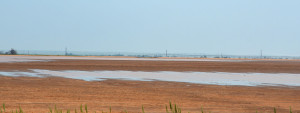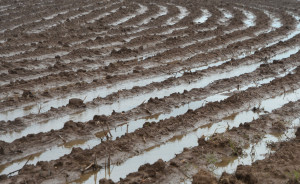Amarillo, Texas, USA
May 29, 2015
Recent rain and cool temperatures across the Panhandle and South Plains have almost guaranteed that cotton producers who have not yet found a window for planting will choose not to plant this year, said Texas A&M AgriLife Extension Service specialists.

The sandy lands in the eastern part of the Texas Panhandle are still holding water in the low-lying areas, preventing cotton planting. (Texas A&M AgriLife Communications photo)
“As we approach the end of May, it is becoming risky to plant cotton in the Texas Panhandle,” said Dr. Jourdan Bell, AgriLife Extension agronomist in Amarillo. “As a result of the heavy spring rains and cool soil temperatures, we only have about 25 percent of our cotton acreage planted across the northern Texas Panhandle.”
For insurance purposes, Bell said, May 31 is the final plant date for most northern Panhandle counties, as well as Swisher and Lamb counties. Hale and Lubbock counties have until June 5, Donley County until June 10 and Hall County’s deadline is June 20.
Because cotton development is driven by growing degree days, Bell said it is possible that late-planted cotton in the Panhandle region may not acquire enough growing degree days for cotton to mature before the first freeze.
Cotton needs 2,200 to 2,600 growing degree days from planting through maturity, she said. But in addition to the seasonal requirement, research has shown that if growing degree days received from planting through the seedling stage are limited, lint yield can be reduced by up to 20 percent.

Rows of standing water have kept cotton farmers out of fields for weeks. (Texas A&M AgriLife Communications photo by Kay Ledbetter)
Another concern is herbicides, Bell said. Many producers had already put out pre-emergent herbicides in anticipation of planting cotton prior to the rains.
Dr. Wayne Keeling, Texas A&M AgriLife Research agronomist in Lubbock, said producers do not necessarily have to rule out sorghum or even an earlier maturity class of corn on trifluralin ground. Because trifluralin is bound very tightly in the soil, they can plant below the herbicide.
Depending on how deep the herbicide was incorporated, Keeling said “trash whippers” work well to push trifluralin soil away from the seed.
“If you plant below the herbicide, the cotyledon can grow through the herbicide, but if you plant on top of the herbicide, the roots will grow through the herbicide, and you will see quick herbicide damage,” he said.
The damage can be detected within four to five days after planting as long as soil temperatures are ideal to promote germination, Keeling said.
He said the recent rains will not wash away the herbicide and alleviate the problem. It is best to plant under ideal conditions with soil temperatures at 65 degrees for 10 days to ensure vigorous early growth.
“Planting in the current conditions with cool soil temperatures will result in stressed plants that will be more susceptible to herbicide issues in addition to the other problems such as disease and pest problems,” Keeling said.
Bell also said on ground where producers used other cotton pre-emergent herbicides such as Staple or Caparol, producers have options such as planting sunflowers, black-eyed peas and soybeans.
For more information on crop restrictions for herbicide applied for cotton, go to http://bit.ly/1HOIFCd.